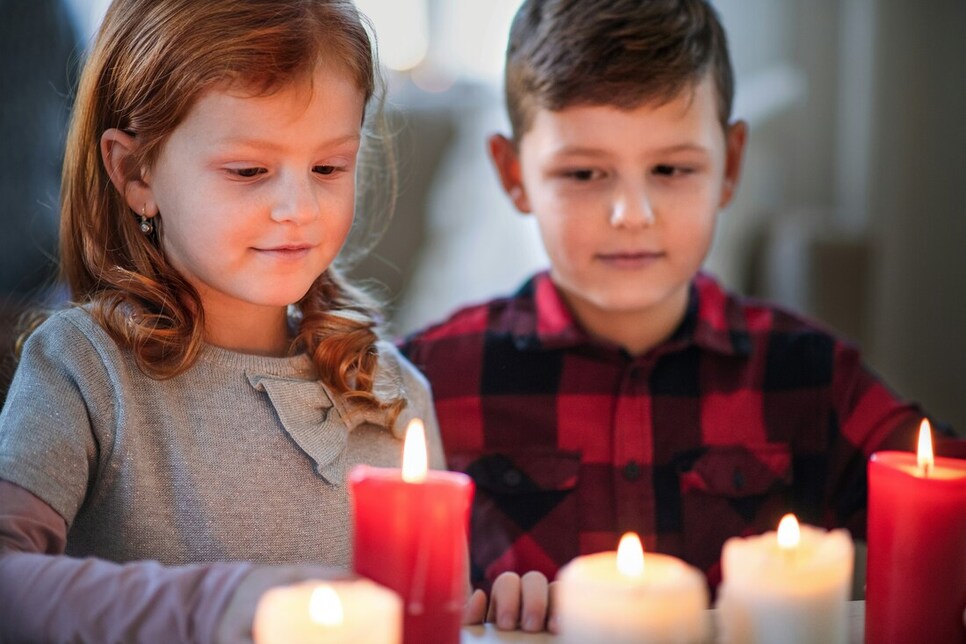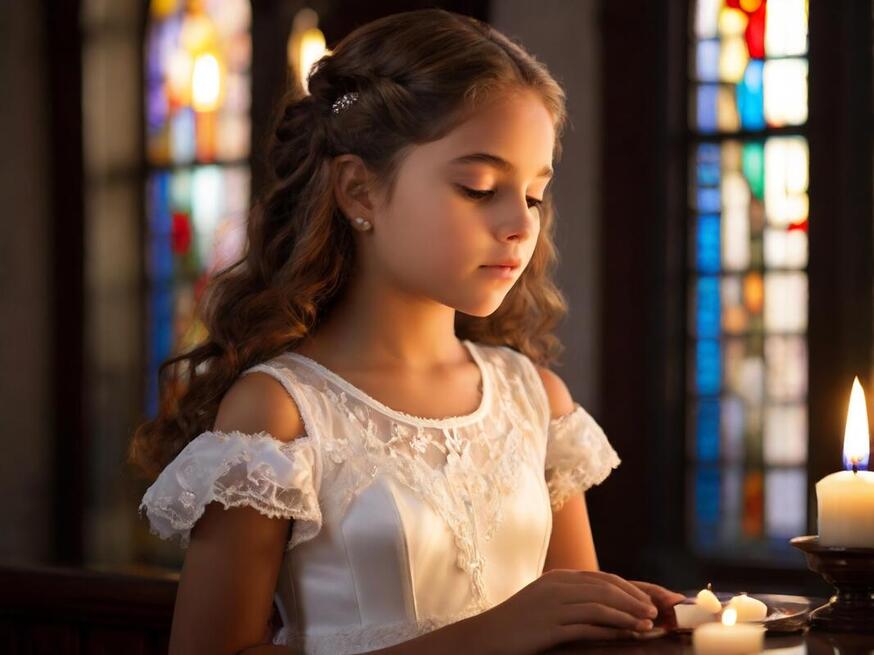Let the Little Children Have Their Own Liturgy of the Word
By Anne McGowan
When my husband and I brought each of our babies for baptism, the church posed two questions: “What name do you give your child?” and “What do you ask of God’s church?” The standard answer to the second question in the Order of Baptism of Children is “baptism,” which also bestows on those children the new name of “Christian.” The vision of the Second Vatican Council grounded the liturgical identity and participation of Christians in the sacrament of baptism, declaring that full, conscious, and active participation is “demanded by the very nature of the liturgy,” is the “right and duty [of all the faithful] by reason of their baptism,” and is the “aim to be considered before all else” in guiding liturgical renewal.
If all the baptised have the capacity for liturgy, even the littlest ones, Catholic parishes do children a disservice when they fail to welcome and accommodate the full liturgical engagement of children in developmentally appropriate ways.
If all the baptised have the capacity for liturgy, even the littlest ones, Catholic parishes do children a disservice when they fail to welcome and accommodate the full liturgical engagement of children in developmentally appropriate ways.
Children’s Liturgy of the Word (CLOW) manifests the church’s hospitality toward children as Christian believers who are called, like everyone else, to grow in their faith through liturgical celebrations. CLOW derives ultimately from another insight of Vatican II: Liturgy must allow “legitimate variations and adaptations to different groups, regions, and peoples.” The Directory for Masses with Children (DMC), issued by the Congregation for Divine Worship in 1973, provides guidance for Masses “with children who have not yet entered the period of preadolescence,” focusing especially on baptised children who have not yet completed their sacramental initiation through confirmation and Eucharist and who may still be relatively new recipients of holy communion.
The DMC acknowledges special affinities and characteristics of young children that shape the ways they often prefer to engage liturgy—for example, through ritual repetition; through music, singing, and embodied sensory interactions; and with extra help settling into short periods of silence. The DMC seeks to combat potential spiritual harm that may result when “children repeatedly experience in the Church things that are barely comprehensible” while at the same time it seeks to lead children toward the goal of full participation in the one liturgical assembly of the local church where God is worshipped as Mystery beyond anyone’s understanding.
To that end, “Sometimes . . . if the place itself and the nature of the community permit, it will be appropriate to celebrate the Liturgy of the Word, including a homily, with the children in a separate, but not too distant, room,” with young children rejoining older children and adults for the liturgy of the Eucharist.
When implemented as intended, CLOW offers several benefits not just to children but to the entire parish.
The DMC acknowledges special affinities and characteristics of young children that shape the ways they often prefer to engage liturgy—for example, through ritual repetition; through music, singing, and embodied sensory interactions; and with extra help settling into short periods of silence. The DMC seeks to combat potential spiritual harm that may result when “children repeatedly experience in the Church things that are barely comprehensible” while at the same time it seeks to lead children toward the goal of full participation in the one liturgical assembly of the local church where God is worshipped as Mystery beyond anyone’s understanding.
To that end, “Sometimes . . . if the place itself and the nature of the community permit, it will be appropriate to celebrate the Liturgy of the Word, including a homily, with the children in a separate, but not too distant, room,” with young children rejoining older children and adults for the liturgy of the Eucharist.
When implemented as intended, CLOW offers several benefits not just to children but to the entire parish.
CLOW Highlights Children as Welcomed Members of the Liturgical Assembly
At Masses where young children are invited to participate in CLOW, they are called forth for a formal dismissal from the main assembly at the beginning of the liturgy of the Word. Their return is typically timed so that everyone can share together in the liturgy of the Eucharist and the concluding rites.
Seeing the joy and enthusiasm children display when given the opportunity to hear and respond to God’s word can be a powerful witness to adult assembly members that might help them be more tolerant of wiggles or interjections not made at church-whisper volume from these same children during other parts of Mass.
The ritual rhythm of CLOW can also remind presiders to do what the DMC suggests even at parish Masses without CLOW—regularly acknowledge the presence and concerns of children in comments made at the beginning and end of Mass and during the homily.
CLOW forms children as missionary disciples who hear and respond to God’s word
CLOW provides children with a robust, age-appropriate experience of liturgy that parallels what is happening in the assembly they just left. Perhaps after a brief resettling activity like a song or prayer, children hear God’s word proclaimed in one or more readings from scripture (always including the gospel). These readings may come from the Lectionary for Masses with Children, which draws on a biblical translation that uses simple but not childish language. Children sing the responsorial psalm’s refrain and the gospel acclamation.
Someone preaches so that, having heard God’s word, the children might come to believe more fully (see Rom. 10:14) and begin to apply it to their lives. Children then profess their faith—the shared faith of the whole church—by reciting the Apostles’ Creed, responding to creedal questions, or repeating a sung refrain when prompted. Little liturgists learn to exercise their role as baptised members of the assembly by offering prayers for the church, the world, those in need, and the local community—likely including some special intentions dearest to their own hearts.
The children’s response to God’s word might incorporate some form of activity after discussing the scripture reading(s), but CLOW is not just catechesis featuring a Bible story, craft, and snack that gives children something to do and older Massgoers some peace. The liturgy of the Word might be the most difficult of the four parts of the Mass for young children to participate in, with its long periods of received proclamation (readings and homily) punctuated by shorter opportunities for more active response (psalm, creed, and prayer of the faithful). By helping younger children navigate the liturgy of the Word in an engaging way, CLOW prepares them to continue listening and responding to God’s word in liturgy and life as they grow in age, grace and wisdom.
CLOW provides insight into good preaching practices
Sofia Cavalletti, a biblical scholar and cofounder of the Catechesis of the Good Shepherd, identified three “mysteries” that fascinate children from a young age: relationship, life and death, and time. Ann M. Garrido develops these themes as ideal foci for preaching with children in Mustard Seed Preaching (Liturgy Training Publications). However, since these mysteries remain equally relevant to adults, homilies that touch on these points likely will resonate with assembly members across the age spectrum, providing further opportunities to foster faith formation for all of God’s children.
In a rare instance of official permission for lay preaching even within Mass, the DMC envisions that non-ordained adults in certain circumstances occasionally might “speak to the children after the gospel, especially if the priest finds it difficult to adapt himself to the mentality of children.”
Any investment a parish makes in its children represents a commitment to the future of the church. Beginning CLOW requires only a supportive pastor, a small space to gather, and trained volunteers who love liturgy, scripture, and listening to what God reveals to little ones.
Enabling baptised children to participate in the liturgy more fully fulfills Jesus’ command to let children come to him without hindrance (Matt 19:14). Puppets, parades, and paper crafts cannot substitute for—and might distract from—formative liturgical experiences that stimulate children’s imaginations and nurture their inclination to wonder and worship. Let us attend to what children will teach us about doing liturgy, listening to the word, and loving God.
Sofia Cavalletti, a biblical scholar and cofounder of the Catechesis of the Good Shepherd, identified three “mysteries” that fascinate children from a young age: relationship, life and death, and time. Ann M. Garrido develops these themes as ideal foci for preaching with children in Mustard Seed Preaching (Liturgy Training Publications). However, since these mysteries remain equally relevant to adults, homilies that touch on these points likely will resonate with assembly members across the age spectrum, providing further opportunities to foster faith formation for all of God’s children.
In a rare instance of official permission for lay preaching even within Mass, the DMC envisions that non-ordained adults in certain circumstances occasionally might “speak to the children after the gospel, especially if the priest finds it difficult to adapt himself to the mentality of children.”
Any investment a parish makes in its children represents a commitment to the future of the church. Beginning CLOW requires only a supportive pastor, a small space to gather, and trained volunteers who love liturgy, scripture, and listening to what God reveals to little ones.
Enabling baptised children to participate in the liturgy more fully fulfills Jesus’ command to let children come to him without hindrance (Matt 19:14). Puppets, parades, and paper crafts cannot substitute for—and might distract from—formative liturgical experiences that stimulate children’s imaginations and nurture their inclination to wonder and worship. Let us attend to what children will teach us about doing liturgy, listening to the word, and loving God.
|
Anne McGowan is an associate professor of liturgy at Catholic Theological Union in Chicago where she teaches courses on liturgy and sacraments. She explores how sacramental rites and catechesis involve the sacramental awareness of children and recognise young people as capable of appropriating and enacting Christian faith at a level appropriate to their embodied existence and chronological and intellectual maturity. She is the mother of two young children. This article also appears in the June 2021 issue of U.S. Catholic (Vol. 86, No. 6, pages 31-35). Images from Unsplash, Pixabay and Freepik. Used under license/with permission. |






